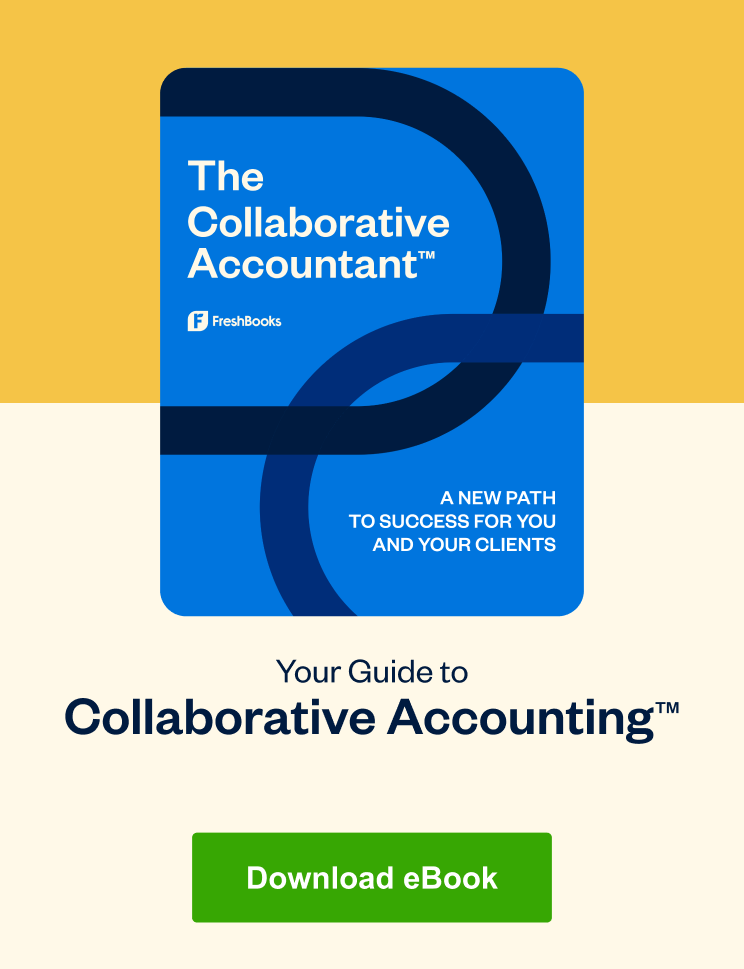Go beyond compliance services to help your clients thrive.

I love the energy before a footrace. Everyone is milling around, stretching, jogging, and getting ready to go, before they’ve even crossed the starting line. Then everyone toes the line, the countdown starts, and things get real very fast.
If you’ve made the decision to start offering advisory services, you’ve already begun that warm-up process. (Need context? Read more about what advisory services are.) Hopefully, you can feel the excitement and you’re ready to jump in. But how do you actually cross the starting line and get moving with advisory in your business?
Let’s talk about what that looks like, what you’ll need, and how to grow a sustainable and profitable advisory side for your firm.
Table of Contents
Which Advisory Services Should I Offer?
When you first begin offering advisory services, I highly recommend focusing on just one or two services to gain some momentum.
Current clients are usually the best place to start. Since you already have a relationship with them, it’s like you have a ready-made focus group to help you target your advisory services. Ask them about their needs and focus on the advisory service that will have the biggest impact on their businesses and their lives.
It’s easy to dive right into the numbers when you talk to your clients, but try to resist that temptation. It can be a powerful and transformative experience to take some time really getting to know your clients, and asking deeper questions about their needs and goals.
Questions to Ask Clients
Here are a few questions I love to ask:
Why did you start this business?
Understanding your client’s motivations helps you connect with their “why.” A small business owner who is passionate about offering a particular product or service will have different needs than an owner who is in it for the thrill of creating something from the ground up, or is enticed by the freedom and flexibility that comes with being their own boss.
What keeps you up at night?
It’s very important to understand what stresses your clients out. (Is it cash flow? Tax advice?) You may be able to look at their books and identify their biggest problems, but it’s the problems they feel most deeply that they’ll be willing to pay you to solve.
These are the solutions that not only help your clients save money (or make more) but also reduce their stress and improve their lives as business owners. That kind of guidance is priceless.
Where do you want your business to go in the next 3 to 5 years?
Clients need your expert guidance to reach their goals, and you need to know what those goals are in order to provide the right services. It’s also good to get your clients thinking about the future. A lot of small business owners might get caught up in their day-to-day work. But, if they don’t typically think that far down the road, they may not realize just how much help they need to reach their goals.
Questions to Ask Yourself
You’ll also want to take a look at what you do best (and what you’re interested in learning) to see where to start. This could lead you to make suggestions to your existing clients or even seek out new client niches that have a strong need for your services.
For example, if you want to offer training or education, you may seek out clients who are further along in their entrepreneurial journey and already have some in-house staff.
Here are some questions to ask yourself:
- What expertise can I provide to my clients?
- What problems can I help them solve?
- What risks can I help them mitigate?
- What tasks can I take off their plate and how many hours will that save them?
- Where can I help them save money?
Ultimately, the winning answer is at the crossroads of your skills/knowledge and your clients’ biggest needs. The questions above can form a starting point to help you dial in on the one or two services that are the best fit for you and your clientele.
How Do I Find Advisory Clients?
Again, there’s no better place to start than with your existing clients. Reach out and let them know about the services you’re offering, or sit down with them and discuss their needs to help you decide what to offer. Starting internally allows you to grow and build the advisory side of your firm with clients who already know, like, and trust you.
As in any business, selling more to your existing clients is a smart move. It’s more cost-efficient than marketing to prospects. The rapport you’ve built with your current client base can often lead to referrals as well.
As you establish yourself in advisory, you can start to branch out and find new clients in need of your advisory services specialty. Your conversations with existing clients can help you identify the type of businesses that will see the value of advisory accounting. Use them as a model to figure out who you’re looking for when you communicate with new prospects.
Rethinking Your Ideal Client
Many bookkeepers and accountants have traditionally sought out “simple” clients. They may have avoided businesses with high-volume transactions, inventory, or complex sales tax issues. From a compliance services standpoint, these clients may take up a lot of your time. But that complexity is precisely what can make them ideal when it comes to selling advisory services. Start looking at “difficult” clients as opportunities and thinking about how to use your expertise to solve their complex problems.
Your ideal client profile also goes beyond just industry and business size. As an advisor, your ideal client is one who truly values what you have to offer. You want someone who is open to listening and applying your advice, and sees you as a partner in their success, not just a technician hired to do a job.
The accounting industry has gone through a major evolution in the past few years, as accounting tech has gotten smarter. Accounting, bookkeeping, and auditing are some of the industries most susceptible to automation—with a 98% probability of being computerizable—according to a University of Oxford study.
The data entry and compliance side of accounting can now be largely automated or done much more easily by in-house staff. This frees the accounting specialist to take on a more strategic role. Clients who appreciate this will be excited to partner with you to streamline their business, optimize their financial decisions, and grow under your guidance.
Small businesses that are comfortable in the status quo are least likely to seek out and value (or actually listen to) your expert advice. Consider looking instead for those businesses that are in a growth phase. These business owners see the value of following a guide, and are dealing with a lot of new problems and questions they’ve never dealt with before.
What Do I Need to Make Advisory Services Work?
Do you have what it takes to offer accounting advisory services?
On the one hand, yes! Don’t ever sell yourself short on the value of your knowledge and experience. What you know can help business owners reach their goals and improve their lives.
However, if you want to get them the best possible results and do it in a way that also helps you grow your practice, there are probably a few things you need to start building into your accounting or bookkeeping firm right away.
Expertise in One or More Advisory Areas
First, the more you focus on advisory in a certain area, the more your expertise needs to grow. The most successful advisors are lifelong learners who stay on top of new developments and are always on the lookout for continuing education in their area of focus. You want to make yourself the go-to expert for your advisory clients.
Communication Skills
As we’ve already discussed, advisory services are all about partnering with your clients and solving their most pressing problems. That means you need to communicate, communicate, communicate. Make sure you have clear, frequent communication with your clients that begins with listening to their concerns. Make sure your expert insights are always shared in a language they can understand. Using accounting jargon can be a tough habit to overcome.
Ability to Learn New Tools
Advisory services may require you to use different tech tools and workflows than you’re used to for your compliance work. You’re delivering a very different type of service as well as collaborating with in-house accounting staff, or your own bookkeeping and accounting team doing the day-to-day books. This can take some time to get used to, so don’t get discouraged.
Willingness to Let Go of Compliance Services
One of the biggest adjustments for many accounting professionals is getting used to letting go. As you take on a more advisory role, you’ll need to let go of some of the day-to-day compliance accounting and bookkeeping. Whether that’s being handled by the business owner themselves or delegated to someone on your team, it can be a major mental shift to trust someone else with the books. Resist the temptation to micromanage here, so you don’t fill your days with hours of work you’re not being paid to do.
Lacing Up Your Advisory Services Packages
Before things really get going, you’ll want to make sure you’re super clear on the packages you’re offering. This may have been straightforward with compliance services, but it’s a bit more complex with advisory.
When your client hires you as a trusted advisor, what do they get? Will they get:
- Weekly meetings?
- Video calls?
- Unlimited email access?
- 3 a.m. phone therapy?
- Deliverables such as cash flow forecasting or financial health reporting?
If you don’t clearly define the scope of your services, they can quickly become all of the above and more at the worst possible moment. Your clients are likely to need our help as decisions come up—and they’ll be relieved to have you in their corner—but you need to set the expectation for what that looks like and what it doesn’t.
Setting clear boundaries from the start protects your time and profitability. It also lets your client know what to expect, which can protect the relationship. After all, the goal of your advisory services is not only to help your clients improve financially, but also to make it easier and less stressful to run their business. Make sure the client/advisor relationship moves you towards that goal too.
Choosing the Right Accounting Software for Advisory
Now that you’ve chosen the services you’ll offer, the clients you want to serve, and the resources you’ll need to be successful, you’re almost ready to run. All you need now is the right equipment.
If you’re still relying on desktop software, you’ll have a lot of hurdles to clear when it comes to building your accounting advisory services practice. You need easy access to your clients’ books and reports so you can monitor when needed and stay current on any key metrics and financial reporting as they move towards their goals. Cloud-based platforms make this much easier, streamlining the process and making your services more convenient, and thus even more valuable to your clients.
Remember, not all cloud accounting software is the same. And while I may be biased, I find FreshBooks to be the perfect platform for building your advisory practice. FreshBooks gives you easy access to your clients’ financials so you can analyze and evaluate their needs, and help guide their decisions. Since FreshBooks is made with small business owners in mind, it’s also simple for them to use for their own day-to-day work while you collaborate with them on high-level advising.
FreshBooks’ Accounting Partner Program is also a great resource. It can help you connect with new clients, and with other bookkeepers and accountants who could be great resource and collaboration partners as you shift from daily bookkeeping or year-end compliance to advisory services.
Play the Long Game
If you only remember one piece of advice as you toe the starting line of advisory services, it’s this: Growing your firm is a marathon, not a sprint. Nine times out of ten, the person who shoots out of the starting gate too fast will be struggling a few miles in while everyone else passes them by. Make sure that’s not you. Pace yourself and you’ll be just fine.
Take the time to master one aspect of advisory at a time. Add one new service and make sure you have it down before you add another. You can adjust on the fly and keep growing step-by-step. Just keep putting one foot in front of the other and enjoy the ride.

Written by Twyla Verhelst, CPA, Founder of the Accountant Channel, FreshBooks
Posted on June 18, 2021


 Collaborative Accounting Is a Better Way to Work for Accountants and Clients
Collaborative Accounting Is a Better Way to Work for Accountants and Clients What Are Accounting Advisory Services? Here’s What You Need to Know
What Are Accounting Advisory Services? Here’s What You Need to Know How to Develop an Accounting Niche That Reflects Your Values
How to Develop an Accounting Niche That Reflects Your Values

![The 5 W's of Scaling Accounting Advisory Services [webinar] cover image](https://www.staging.freshenv.com/blog/wp-content/uploads/2021/04/hero-accounting-webinar-5ws-advisory-226x150.png)



